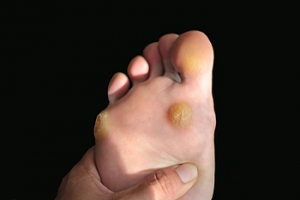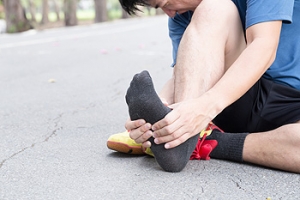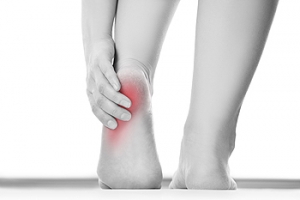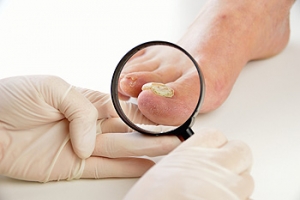

What is a Plantar Wart?
 There are many different types of warts, and a condition known as plantar warts appear on the sole of the foot. While warts on other parts of the body may grow out, plantar warts grow into the heel of the foot as a result of the pressure the foot endures while standing and walking. This typically causes considerable pain and discomfort and may appear as bumpy growths on the sole of foot. It comes from the human papilloma virus, which is also known as the HPV virus, and may enter the body through small scrapes or cuts. This particular type of virus is known to be contagious and generally thrives in public swimming areas and showers. It may be beneficial to wear appropriate shoes while in these areas which may aid in preventing the spreading of this condition. If you are afflicted with plantar warts, it’s advised to consult with a podiatrist so proper treatment can be obtained.
There are many different types of warts, and a condition known as plantar warts appear on the sole of the foot. While warts on other parts of the body may grow out, plantar warts grow into the heel of the foot as a result of the pressure the foot endures while standing and walking. This typically causes considerable pain and discomfort and may appear as bumpy growths on the sole of foot. It comes from the human papilloma virus, which is also known as the HPV virus, and may enter the body through small scrapes or cuts. This particular type of virus is known to be contagious and generally thrives in public swimming areas and showers. It may be beneficial to wear appropriate shoes while in these areas which may aid in preventing the spreading of this condition. If you are afflicted with plantar warts, it’s advised to consult with a podiatrist so proper treatment can be obtained.
Plantar warts can be very uncomfortable. If you need your feet checked, contact Dr. Randy Garr from Bigfoot Podiatry. Our doctor will assist you with all of your foot and ankle needs.
About Plantar Warts
Plantar warts are the result of HPV, or human papillomavirus, getting into open wounds on the feet. They are mostly found on the heels or balls of the feet.
While plantar warts are generally harmless, those experiencing excessive pain or those suffering from diabetes or a compromised immune system require immediate medical care. Plantar warts are easily diagnosed, usually through scraping off a bit of rough skin or by getting a biopsy.
Symptoms
- Lesions on the bottom of your feet, usually rough and grainy
- Hard or thick callused spots
- Wart seeds, which are small clotted blood vessels that look like little black spots
- Pain, discomfort, or tenderness of your feet when walking or standing
Treatment
- Freezing
- Electric tool removal
- Laser Treatment
- Topical Creams (prescription only)
- Over-the-counter medications
To help prevent developing plantar warts, avoid walking barefoot over abrasive surfaces that can cause cuts or wounds for HPV to get into. Avoiding direct contact with other warts, as well as not picking or rubbing existing warts, can help prevent the further spread of plantar warts. However, if you think you have developed plantar warts, speak to your podiatrist. He or she can diagnose the warts on your feet and recommend the appropriate treatment options.
If you have any questions please feel free to contact our office located in Provo, UT . We offer the newest diagnostic and treatment technologies for all your foot and ankle needs.
All About Plantar Warts
Plantar warts are warts that are only found on the feet, hence the term “plantar”, which means “relating to the foot.” They are caused by the human papillomavirus, or HPV, and occur when this virus gets into open wounds on the feet. The warts themselves are hard bumps on the foot. They are easily recognizable, mostly found on the heels or ball of the foot. Plantar warts are non-malignant, but they can cause some pain, discomfort, and are often unsightly. Removing them is a common step toward treating them.
Plantar warts can cause some pain while standing, sometimes felt as tenderness on the sole of your foot. Unless the wart has grown into the foot behind a callus, you will be able to see the fleshy wart. A podiatrist should only be consulted if there is an excessive amount of pain. Plantar warts are not cancerous or dangerous, but they can affect your walking and continually reappear. Anyone who suffers from diabetes or a compromised immune system disease should seek out care immediately.
Podiatrists are easily able to diagnose plantar warts. They usually scrape off a tiny bit of the rough skin to make tiny blood clots visible and examine the inside of warts. However, a biopsy can be done if the doctor is not able to diagnose them from simply looking at them. Although plantar warts usually do not require an excessive amount of treatment, there are ways to go about removing them. A common method is to freeze them off using liquid nitrogen, removing them using an electrical tool, or burning them off via laser treatment. For a less invasive treatment option, topical creams can be used through a doctor’s prescription. This treatment method takes more time, however. Keep the wart covered for protection in between daily treatments.
The best way to avoid developing plantar warts is to avoid walking barefoot in public places. Avoid this especially if you have open sores or cuts on your feet. It is also important to avoid direct contact with warts in general, as they are highly contagious.
How to Prevent Running Injuries From Occurring
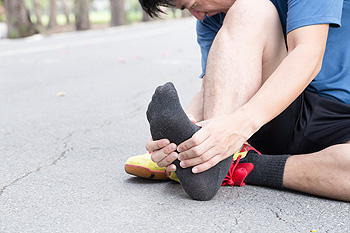 Many joggers are acutely aware of how incurring an injury can hinder running activities. Achilles tendinitis is a common injury that is felt by runners who increase the miles they run in a short amount of time. The Achilles tendon is considered to be the longest tendon in the body and it connects the heel bone to the calf. Symptoms of this includes severe pain and tenderness at the back of the heel, and the pain may extend to the calf. This may be prevented by strengthening the calf muscle which can be accomplished by standing on a step and then alternating lowering the heels until a gentle stretch is felt. Additionally, shin splints can be a common injury and can produce considerable pain and soreness. This discomfort can often be felt from the shin to the arch of the foot. Wearing the correct shoes may aid in preventing this condition in addition to strengthening the foot by performing toe raises while holding dumbbells. It’s important to speak with a podiatrist for additional information on how to protect the feet from running injuries.
Many joggers are acutely aware of how incurring an injury can hinder running activities. Achilles tendinitis is a common injury that is felt by runners who increase the miles they run in a short amount of time. The Achilles tendon is considered to be the longest tendon in the body and it connects the heel bone to the calf. Symptoms of this includes severe pain and tenderness at the back of the heel, and the pain may extend to the calf. This may be prevented by strengthening the calf muscle which can be accomplished by standing on a step and then alternating lowering the heels until a gentle stretch is felt. Additionally, shin splints can be a common injury and can produce considerable pain and soreness. This discomfort can often be felt from the shin to the arch of the foot. Wearing the correct shoes may aid in preventing this condition in addition to strengthening the foot by performing toe raises while holding dumbbells. It’s important to speak with a podiatrist for additional information on how to protect the feet from running injuries.
All runners should take extra precaution when trying to avoid injury. If you have any concerns about your feet, contact Dr. Randy Garr of Bigfoot Podiatry. Our doctor will treat your foot and ankle needs.
How to Prevent Running Injuries
There are a lot of mistakes a runner can make prior to a workout that can induce injury. A lot of athletes tend to overstretch before running, instead of saving those workouts for a post-run routine. Deep lunges and hand-to-toe hamstring pulls should be performed after a workout instead of during a warmup. Another common mistake is jumping into an intense routine before your body is physically prepared for it. You should try to ease your way into long-distance running instead of forcing yourself to rush into it.
More Tips for Preventing Injury
- Incorporate Strength Training into Workouts - This will help improve the body’s overall athleticism
- Improve and Maintain Your Flexibility – Stretching everyday will help improve overall performance
- “Warm Up” Before Running and “Cool Down” Afterward – A warm up of 5-10 minutes helps get rid of lactic acid in the muscles and prevents delayed muscle soreness
- Cross-Training is Crucial
- Wear Proper Running Shoes
- Have a Formal Gait Analysis – Poor biomechanics can easily cause injury
If you have any questions, please feel free to contact our office located in Provo, UT . We offer the newest diagnostic and treatment technologies for all your foot care needs.
How to Prevent Running Injuries
Overtraining and overusing the feet are the main causes of common running injuries. A number of these common injuries are caused by overrunning. Runner’s knee is a condition that is characterized by the back of the kneecap beginning to wear away and cause pain in the knee. This frequently occurs due to either a decrease in strength in the quadriceps muscles or ill-fitting shoes that are lacking in proper support for the inside of the forefoot. Strengthening exercises focusing on the quad muscle and sports orthotics are the usual treatments for those suffering from runner’s knee. Prevention of the condition lies in a focus on hip strengthening and quad-strengthening to keep the kneecap aligned. To help learn the best exercise to heal runner’s knee, one can also undergo physical therapy.
One common injury, called iliotibial band syndrome, is often caused by overtraining. This condition occurs when the iliotibial band gets irritated, creating pain and discomfort in the outside knee area. Plantar fasciitis, another common running injury, also occurs as a result of inflammation and irritation. Plantar fasciitis is an inflammation and irritation of the bone in the foot. A large amount of pain is often experienced due to plantar fasciitis. The condition can be caused by a high arch, improper footwear, tight muscles, or flat feet. It can best be avoided by stretching and wearing appropriate footwear that supports the foot.
Another common injury for runners is stress fractures. These injuries occur due to running style, overtraining, or a lack of calcium. Stress fractures most often occur in several locations in runners, including the inner bone of the leg, the thighbone, the bone at the base of the spine and the bones of the toes. Stress fractures are best prevented by wearing proper footwear and by running on flat and hard surfaces; this will absorb some of the shock created during running.
Aside from overtraining, other causes of common running injuries include ill-fitting footwear, a lack of flexibility and strength, and irregular biomechanics. The best way to avoid running injuries is to prevent them from even occurring. Both iliotibial band syndrome and stress fractures are preventable. The first step that should be taken to prevent running injuries is to only wear footwear that fits properly and that is appropriate for whatever activity you are doing. Running shoes are the only protective gear available to runners that can safeguard them from sustaining injuries. Choosing the right pair of shoes is therefore extremely important. While running shoes are an important factor, it is also important to consider other facets of your running routine such as training schedules, flexibility, and strengthening. These elements should be considered and altered according to your running needs to best maximize your run and minimize the possibility of injury. Careful stretching before and after a run should also be considered to help prevent running injuries. Stretching muscles enables greater flexibility and a lesser chance of sustaining injury.
What is a Heel Spur?
 Excess calcium that develops on the heel of the foot may be referred to as a heel spur. It is often noticed by feeling an intense pain in the heel while standing, especially in the morning. Additional symptoms may include swelling, tenderness and an achiness that is felt throughout the day. When an X-ray is performed, a small protrusion is generally visible on the heel of the foot. This condition will typically develop gradually, and is often the result of engaging in activities that wear down the tissues in the arches and heels. Wearing poorly fitting shoes that lack adequate cushioning may be a common reason for heel spurs to form, in addition to being overweight which may contribute to the amount of pressure the heels must endure. Research has shown the importance of resting the feet so the pain may subside. There are several treatment options for heel spurs and it’s suggested to consult with a podiatrist for additional information.
Excess calcium that develops on the heel of the foot may be referred to as a heel spur. It is often noticed by feeling an intense pain in the heel while standing, especially in the morning. Additional symptoms may include swelling, tenderness and an achiness that is felt throughout the day. When an X-ray is performed, a small protrusion is generally visible on the heel of the foot. This condition will typically develop gradually, and is often the result of engaging in activities that wear down the tissues in the arches and heels. Wearing poorly fitting shoes that lack adequate cushioning may be a common reason for heel spurs to form, in addition to being overweight which may contribute to the amount of pressure the heels must endure. Research has shown the importance of resting the feet so the pain may subside. There are several treatment options for heel spurs and it’s suggested to consult with a podiatrist for additional information.
Heel spurs can be incredibly painful and sometimes may make you unable to participate in physical activities. To get medical care for your heel spurs, contact Dr. Randy Garr from Bigfoot Podiatry. Our doctor will do everything possible to treat your condition.
Heels Spurs
Heel spurs are formed by calcium deposits on the back of the foot where the heel is. This can also be caused by small fragments of bone breaking off one section of the foot, attaching onto the back of the foot. Heel spurs can also be bone growth on the back of the foot and may grow in the direction of the arch of the foot.
Older individuals usually suffer from heel spurs and pain sometimes intensifies with age. One of the main condition's spurs are related to is plantar fasciitis.
Pain
The pain associated with spurs is often because of weight placed on the feet. When someone is walking, their entire weight is concentrated on the feet. Bone spurs then have the tendency to affect other bones and tissues around the foot. As the pain continues, the feet will become tender and sensitive over time.
Treatments
There are many ways to treat heel spurs. If one is suffering from heel spurs in conjunction with pain, there are several methods for healing. Medication, surgery, and herbal care are some options.
If you have any questions feel free to contact our office located in Provo, UT . We offer the latest in diagnostic and treatment technology to meet your needs.
Heel Spurs
Heel spurs are the result of calcium deposits that cause bony protrusions on the underside of the heel. Heel spurs are usually painless, but they have the potential to cause heel pain. Heel spurs tend to be associated with plantar fasciitis, which is a condition that causes inflammation of the band of connective tissue that runs along the bottom of the foot. They most often occur to athletes whose sports involve a lot of running and jumping.
Some risk factors for developing heel spurs include running and jogging on hard surfaces, being obese, wearing poorly fitting shoes, or having walking gait abnormalities.
It is possible to have a heel spur without showing signs of any symptoms. However, if inflammation develops at the point of the spur’s formation, you may have pain while walking or running. In terms of diagnosis, sometimes all a doctor needs to know is that the patient is experiencing a sharp pain localized to the heel to diagnose a heel spur. Other times, an x-ray may be needed to confirm the presence of a heel spur.
Heel spurs can be prevented by wearing well-fitting shoes that have shock-absorbent soles. You should also be sure that you are choosing the right shoe for the activity you want to partake in; for example, do not wear walking shoes when you want to go on a run. Additionally, maintaining a healthy weight can be beneficial toward preventing heel spurs, as it will prevent an excess amount of pressure being placed on the ligaments.
There are a variety of treatment options for people with heel spurs. Some of these include stretching exercises, physical therapy, shoe inserts, or taping and strapping to rest stressed muscles and tendons. If you have heel pain that lasts longer than a month, don’t hesitate to seek help from a podiatrist. Your doctor can help you determine which treatment option is best for you.
How Apple Cider Vinegar May Help Treat Toenail Fungus
 If you notice that your toenails are starting to thicken or change color, there is a chance you may have onychomycosis. Onychomycosis is the medical term for the condition commonly known as toenail fungus. If you are in the early stages of developing toenail fungus, you may notice a white or yellow spot under the tip of your toenail. Afterward, you may notice that the fungus will travel deeper and start to discolor, thicken, or distort the edge of the nail. Nevertheless, there are items you likely have in your kitchen cabinet that can aid in fighting toenail fungus. Apple cider vinegar is a popular remedy for toenail fungus due to its antifungal properties. If you want to treat your fungus using ACV, you can soak your feet in a mixture of warm water and the vinegar for about 15 minutes, twice a day. When purchasing the ACV, you should make sure it is raw, unpasteurized, and organic. For further assistance with treating toenail fungus, please consider scheduling a consultation with a podiatrist.
If you notice that your toenails are starting to thicken or change color, there is a chance you may have onychomycosis. Onychomycosis is the medical term for the condition commonly known as toenail fungus. If you are in the early stages of developing toenail fungus, you may notice a white or yellow spot under the tip of your toenail. Afterward, you may notice that the fungus will travel deeper and start to discolor, thicken, or distort the edge of the nail. Nevertheless, there are items you likely have in your kitchen cabinet that can aid in fighting toenail fungus. Apple cider vinegar is a popular remedy for toenail fungus due to its antifungal properties. If you want to treat your fungus using ACV, you can soak your feet in a mixture of warm water and the vinegar for about 15 minutes, twice a day. When purchasing the ACV, you should make sure it is raw, unpasteurized, and organic. For further assistance with treating toenail fungus, please consider scheduling a consultation with a podiatrist.
If left untreated, toenail fungus may spread to other toenails, skin, or even fingernails. If you suspect you have toenail fungus it is important to seek treatment right away. For more information about treatment, contact Dr. Randy Garr of Bigfoot Podiatry. Our doctor can provide the care you need to keep you pain-free and on your feet.
Symptoms
- Warped or oddly shaped nails
- Yellowish nails
- Loose/separated nail
- Buildup of bits and pieces of nail fragments under the nail
- Brittle, broken, thickened nail
Treatment
If self-care strategies and over-the-counter medications does not help your fungus, your podiatrist may give you a prescription drug instead. Even if you find relief from your toenail fungus symptoms, you may experience a repeat infection in the future.
Prevention
In order to prevent getting toenail fungus in the future, you should always make sure to wash your feet with soap and water. After washing, it is important to dry your feet thoroughly especially in between the toes. When trimming your toenails, be sure to trim straight across instead of in a rounded shape. It is crucial not to cover up discolored nails with nail polish because that will prevent your nail from being able to “breathe”.
In some cases, surgical procedure may be needed to remove the toenail fungus. Consult with your podiatrist about the best treatment options for your case of toenail fungus.
If you have any questions, please feel free to contact our office located in Provo, UT . We offer the newest diagnostic and treatment technologies for all your foot care needs.
Toenail Fungus
Toenail fungus is a frustrating problem that affects many people. It can be persistent and hard to get rid of. As many different types of fungi are present throughout the environment, it is very easy to contract toenail fungus.
The feet are especially susceptible to toenail fungus because shoes and socks create the ideal dark and moist environment that fungal infections thrive in. While fungal infections of the nail plate are quite common, if left untreated they can spread beyond the toenail and into the skin and other parts of the body.
Signs of toenail fungus include a thickened nail that has become yellow or brown in color, a foul smell, and debris beneath the nail. The toe may become painful due to the pressure of a thicker nail or the buildup of debris.
Treatment for toenail fungus is most effective during the early stages of an infection. If there is an accumulation of debris beneath the nail plate, an ingrown nail or a more serious infection can occur. While each treatment varies between patients, your podiatrist may prescribe you oral medications, topical liquids and creams, or laser therapy. To determine the best treatment process for you, be sure to visit your podiatrist at the first signs of toenail fungus.
Symptoms of an Achilles Tendon Injury
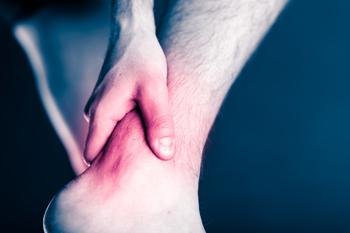 The purpose of the Achilles tendon is to connect the calf muscle to the heel bone. The back of the heel is often the area of discomfort when an injury occurs. Research has shown that it may be common among athletes who participate in running and jumping activities such as soccer, volleyball, softball and similar sports to incur this type of injury. Additionally, the Achilles tendon is referred to as one of the longest tendons in the body, and may endure wear and tear from daily activities such as walking and running. Damage inflicted on the Achilles tendon typically begins with a gradual feeling of discomfort. In cases of an extreme tear, severe pain will be felt immediately. Some of the symptoms that may be experienced with this type of injury can include tenderness when touched, redness and swelling. The ankle may become swollen and stiff, causing difficulty when attempting to move it. Changing the area where the sport or activity takes place in addition to adequately resting the foot is essential for proper healing to commence. A consultation with a podiatrist is suggested for a proper diagnosis and for additional information about an Achilles tendon injury.
The purpose of the Achilles tendon is to connect the calf muscle to the heel bone. The back of the heel is often the area of discomfort when an injury occurs. Research has shown that it may be common among athletes who participate in running and jumping activities such as soccer, volleyball, softball and similar sports to incur this type of injury. Additionally, the Achilles tendon is referred to as one of the longest tendons in the body, and may endure wear and tear from daily activities such as walking and running. Damage inflicted on the Achilles tendon typically begins with a gradual feeling of discomfort. In cases of an extreme tear, severe pain will be felt immediately. Some of the symptoms that may be experienced with this type of injury can include tenderness when touched, redness and swelling. The ankle may become swollen and stiff, causing difficulty when attempting to move it. Changing the area where the sport or activity takes place in addition to adequately resting the foot is essential for proper healing to commence. A consultation with a podiatrist is suggested for a proper diagnosis and for additional information about an Achilles tendon injury.
Achilles tendon injuries need immediate attention to avoid future complications. If you have any concerns, contact Dr. Randy Garr of Bigfoot Podiatry. Our doctor can provide the care you need to keep you pain-free and on your feet.
What Is the Achilles Tendon?
The Achilles tendon is a tendon that connects the lower leg muscles and calf to the heel of the foot. It is the strongest tendon in the human body and is essential for making movement possible. Because this tendon is such an integral part of the body, any injuries to it can create immense difficulties and should immediately be presented to a doctor.
What Are the Symptoms of an Achilles Tendon Injury?
There are various types of injuries that can affect the Achilles tendon. The two most common injuries are Achilles tendinitis and ruptures of the tendon.
Achilles Tendinitis Symptoms
- Inflammation
- Dull to severe pain
- Increased blood flow to the tendon
- Thickening of the tendon
Rupture Symptoms
- Extreme pain and swelling in the foot
- Total immobility
Treatment and Prevention
Achilles tendon injuries are diagnosed by a thorough physical evaluation, which can include an MRI. Treatment involves rest, physical therapy, and in some cases, surgery. However, various preventative measures can be taken to avoid these injuries, such as:
- Thorough stretching of the tendon before and after exercise
- Strengthening exercises like calf raises, squats, leg curls, leg extensions, leg raises, lunges, and leg presses
If you have any questions please feel free to contact our office located in Provo, UT . We offer the newest diagnostic tools and technology to treat your foot and ankle needs.
What are Achilles Tendon Injuries
The Achilles tendon is the strongest tendon in the human body. Its purpose is to connect the lower leg muscles and calf to the heel of the foot. This tendon is responsible for facilitating all types of movement, like walking and running. This tendon provides an enormous amount of mobility for the body. Any injuries inflicted to this tissue should be immediately brought up with a physician to prevent further damage.
The most common injuries that can trouble the Achilles tendon are tendon ruptures and Achilles tendinitis. Achilles tendinitis is the milder of the two injuries. It can be recognized by the following symptoms: inflammation, dull-to-severe pain, increased blood flow to the tendon, thickening of the tendon, and slower movement time. Tendinitis can be treated via several methods and is often diagnosed by an MRI.
An Achilles tendon rupture is trickier to heal, and is by far the most painful injury. It is caused by the tendon ripping or completely snapping. The results are immediate and absolutely devastating, and will render the patient immobile. If a rupture or tear occurs, operative and non-operative methods are available. Once the treatment begins, depending on the severity of the injury, recovery time for these types of issues can take up to a year.
Simple preventative measures can be taken as a means to avoid both injuries. Prior to any movement, taking a few minutes to stretch out the tendon is a great way to stimulate the tissue. Calf raises, squats, leg curls, leg extensions, leg raises, lunges, and leg presses are all suggested ways to help strengthen the lower legs and promote Achilles tendon health.
Many problems arise among athletes and people who overexert themselves while exercising. Problems can also happen among those who do not warm up properly before beginning an activity. Proper, comfortable shoes that fit correctly can also decrease tendon injuries. Some professionals also suggest that when exercising, you should make sure that the floor you are on is cushioned or has a mat. This will relieve pressure on the heels. A healthy diet will also increase tendon health.
It is very important to seek out a podiatrist if you believe you have an injury in the Achilles region. Further damage could result in severe complications that would make being mobile difficult, if not impossible.




